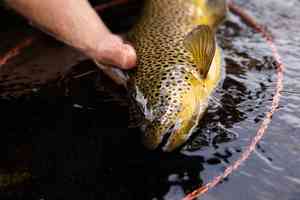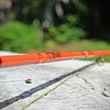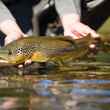Speciality fly lines aren’t anything new in the angling world. Every line manufacturer seems to feature an endless array of lines, from skagit and spey lines to shooting heads, sink tips, and everything in between. A majority of these lines are built to match the industry’s standard fly rod — a fast action 9ft 5wt.
However, one type of line that has seen a lot less attention during the industry’s lust for speed, power, and ridiculously long casts — a line designed for the slow, “classic” style rods (Think the Sage LL, nearly any Winston, or any fiberglass or bamboo fly rod) that are meant to deliver precise, delicate dry fly presentations.
RIO's new Lightline, however, is just that type of line, one designed specifically for slow-to-medium action rods, those rods with a “classic” feel to them. RIO also specifically states that it’s perfect for bamboo and fiberglass rods.
To me, that’s a bold claim to make — that a modern company can design a line that’s a perfect fit for “classic” rods. While the industry is very slowly starting to realize that building rods that more closely resemble broomsticks instead of an actual fly rods doesn’t make a whole lot of sense, especially for trout fishermen, I was still skeptical when the RIO LightLine showed up on my doorstep.
For comparison, I did have some Cortland Finesse Trout II WF5F to cast alongside the LightLine DT5F. The Finesse Trout II is designed for very similar fishing situations that the LightLine is — small dry flies, in complex water, at traditional dry fly distances.
What works
Presentation
Hands-down, the most impressive aspect of the LightLine is just how well it presents a small dry fly, especially on stillwater. One of my favorite streams is essentially a series of beaver ponds, and the browns there are always rising on tiny midges. With the LightLine on, I was able to throw 50’ casts without a problem, turn over a 12’ leader, and land a size 22 Griffith’s gnat on calm water with barely a ripple. In a weight-forward configuration, I’m sure 60-70’ casts wouldn’t be a problem, but casts that long defeat the purpose of this line - for use on classic rods. Classic rods weren’t exactly designed with 70’+ casts in mind.
Compared to the weight-forward Finesse Trout II, the LightLine made a lot less “noise” on the water.
Castability
The LightLine casts marvelously, even for being a true-to-weight line (the weight-forward version of this line is true-to-weight as well). The loops aren’t as fast and tight as a line that’s a half or full-size heavy, but they’re still plenty tight and shoot quickly enough to perform admirably even against a slight headwind. Granted, some of that has to be attributed to the rod you’re fishing the line on — a floppy 3wt glass rod doesn’t have the backbone of a Winston BIIIX, but generally, the line should cast well on most any rod for which it’s designed.
The LightLine is also designed with a very short front taper, which helps it load quicker for short casts on tight water.
Mending
One of the best features of a double-taper line is its mending capabilities, and the LightLine mends as well as any other double-taper line I’ve ever fished. While most of my testing with this line was done tossing dry flies, I did spend some time nymphing with it. It roll casts admirably and mends across complex currents better than any other line I’ve used to date. It certainly mends better than the Finesse Trout II.

Floatability
I’m pretty sure I made up a word there with “floatability” but it’s worth mentioning here that the LightLine does float very high on the water - especially the short front tapers. The ends of the line are coated with what RIO calls “MaxFloat,” a proprietary material that has an off-white color and grainy texture. From my three weeks using the line, I can see it makes a significant difference in how high the tip of the line floats in the water, especially when nymphing.
What doesn’t work
Power
With a double-taper fly line, you do sacrifice the shooting power you get in a weight-forward line. However, since both the weight-forward and double-taper versions of the LightLine are true-to-weight, I’m not sure how much of a difference the weight-forward line would make when needing to shoot through a stiff headwind. Again, a lot of this performance will depend on what rod you’re using - a really, really slow light rod won’t have the power to punch line unless you overline it, and then you’re going to face accuracy problems. Just know going in that when you’re using the LightLine, you don’t want to be using it on a day when the wind is gusting anywhere past 5-8mph.
Color
This might sound like a really nitpicky thing to bring up, but I’m not a fan of the brown/ivory dual color scheme RIO chose to go with on the LightLine. I hooked my leader up to the brown end of the line, and when fishing in low light I can barely see the line on the water. I’d highly recommend attaching your leader to the ivory end of the fly line.
I’d prefer to see a uniform color, something along the lines of the blue of the Finesse Trout II, but again, this is a very minor complaint.
Final Word
RIO has created an absolutely wonderful line for anglers who love to throw dry flies — especially tiny ones. I have a good friend who fishes size 32 flies (I’m not joking at all here) on 8x tippet, and he adored the way the LightLine presented his microscopic offerings.
It mends spectacularly, nymphs well, casts just as you’d expect a true-to-weight double-taper line would, and offers unmatched performance when it comes to laying down small flies on calm water.
The short of it is this — the RIO LightLine over-delivered on its promises. For any angler who loves dry fly fishing, and has an older “classic” rod in their quiver, the LightLine is an absolute must-have fly line. I’d highly recommend it in a double-taper, and at $74.95, it’s right in the price range of what you’d expect to pay for a premium-quality line. The RIO LightLine is truly a dry fly angler’s dream.































Comments